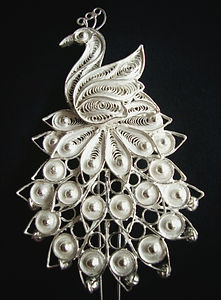TYPICAL ORNAMENTS IN COSTUME
Odissi is a visual art form creating dynamic visuals on stage with the help of costume, make-up and jewellery; this is exactly where ‘Aharaya Abhinaya’ steps in.
Odissi dance is complemented by intricate filigree silver jewelry pieces. Filigree, in French, means “thin wire”, and in Oriya it is called Tarchasi. This highly skilled art form is more than 500 years old and is traditionally done by local artisans on the Eastern shores of Orissa. The jewelry pieces themselves are an important part of the Odissi dancer’s costume and is comprised of the tikka (forehead ornament), allaka (head piece on which the tikka hangs), unique ear covers in intricate shapes (kappa), usually depicting a peacock’s feathers, with jhumkis (bell shaped earrings) hanging from them, two necklaces- a smaller necklace worn close to the neck and a longer necklace with a hanging pendant, and two sets of bangles worn on the upper arm (bahi chudi) and wrist (Kankana). The process of creating each piece takes the collaboration of many artisans each specialized in one step of the many that turns a lump of raw silver into a handcrafted work of art.

Filigree Sinthi: Single jewelry piece placed on the hair and forehead

Filigiri Kappas: Unique ear covers in shapes usually depicting a peacock’s feathers with bell shaped earrings
-01.jpeg)
Long necklace with a
hanging pendant.

Antique Bahichudi: Armlets worn on the upper arm.

Antique Odissi Kankana:
Bangles

Kankana (Bangles) with intricate designs

Bengapatti: elaborate belt worn on the waist made of silver or similar materials

Ankle Bells – Ghungroo Usually 50 to 100 in numbers strung together on a cotton rope


Mukoot or Pushpachuda
Pushpachuda around the bun (Tahiya inserted in the middle of the bun)
The Mukoot consists of two parts i.e. Ghoba and Tahiya. The flower decorated back piece, called the Ghoba, sits around the dancer’s hair pulled into a bun at the back of the head. The longer piece that emerges from the center of the back piece is called the Tahiya, and this represents the temple spire of Lord Jagannath or the flute of Lord Krishna.
Other Hair Accessories



